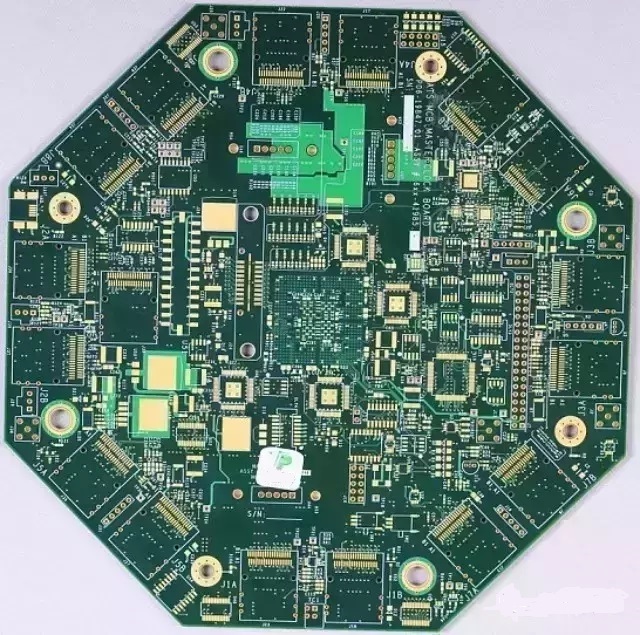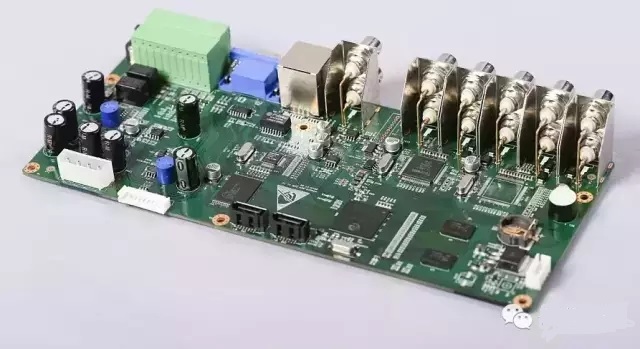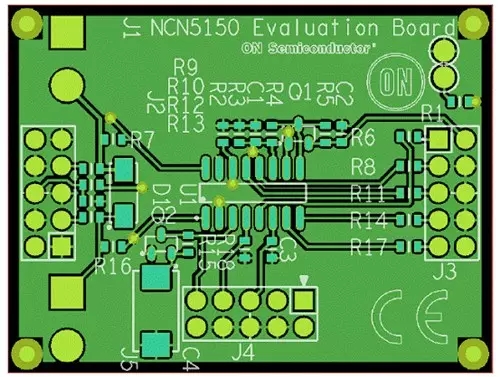
The most basic purpose of the surface treatment is to ensure good solderability or electrical properties.Because the copper in the air tend to exist in the form of oxides, it is unlikely to maintain the original copper for a long time,so copper require additional processing. Although in the subsequent assembly ,a strong flux can be used to remove oxide of most copper,but flux itself is difficult to remove,so the industry generally do not use strong flux.There are many PCB surface treatment.The common treatments have hot air leveling (HASL), organic coating (OSP), electroless nickel / immersion gold (ENIG), immersion silver and immersion tin.The following will be introduced one by one.
1. The hot air leveling (HASL)
The hot air leveling is also called hot air solder leveling.It is the technology that coat the PCB surface with molten tin-lead solder and heat the compressed air to blow leveling,to form a coating layer that prevents the copper from being oxidated,but also provides good solderability.When in HAL,solder and copper form copper-tin intermetallic at the junction.The thickness of solder that protect the copper surface is about 7 ~ 11μm.When in HAL,PCB need to be immersed in molten solder. Air knife blow leveling the solder before solidification of the solder ;Air knife can make the crescent-shaped solder on the copper surface minimize and prevent solder bridging.
HASL is divided into two kinds of vertical and horizontal. It is generally believed that horizontal is better, mainly because the coating of horizontal HASL is more uniform ,and can be achieved automated production. Thickness of HASL solder and flatness of pad is difficult to control,and it is difficult to mount a narrow pitch components. Lead-Free HASL:it replaces Pb-Sn with non-Pb-Sn metal or lead-free solder alloys.
The general process of hot air leveling process is :micro-corrosion→preheating →coating flux→spray tin-cleaning.
2. Organic coating (OSP)
Organic coating process is different from other surface treatment processes.It is to act as a barrier layer between the copper and air. Organic coating process is simple, low cost, which makes it possible to widely be used in the industry.Molecular of early organic coating is imidazole and benzotriazole with the role of rust protection.The latest molecular is mainly benzimidazole.In the subsequent soldering process,if surface of copper has only one organic coating layer,that is not OK.It must be a lot of layers.
This is why you usually need to add copper solution into a chemical bath. After the first layer of the coating, the coating layer adsorbs copper;then organic coating molecules of the second layer combine copper.Until twenty or even a hundred times ,organic coating molecules assemble in the copper surface,which can ensure many times reflow soldering. Test showed that: the latest organic coating process can maintain good performance in a number of lead-free soldering process.
The general process of organic coating process is as follows: degreasing → micro etching→ acid washing→ water washing→the organic coating→ washing.Process control is relatively easier for other surface treatment processes
3. electroless nickel / immersion gold (ENIG)
Electroless Nickel / Immersion Gold Process is not as simple as organic coating.Electroless nickel / immersion gold seems to give PCB to wear thick armor. Additionally, electroless nickel / immersion gold process is unlike organic coating as rust-proof barrier,and it can be useful and has good electrical properties in long-term use of PCB.Therefore, electroless nickel / immersion gold wraps a thick layer of nickel-gold alloy with good electrical properties on copper surface, which can protect PCB for a long time. In addition,it also has the patience for the environment that other surface treatment processes do not have.
The reason of plating nickel is due to interdiffusion between gold and copper, and the nickel layer can prevent the spread between gold and copper; if there is no layer of nickel, gold will spread into the copper in a few hours.Another benefit of Electroless Nickel / Immersion Gold is the strength of nickel. Nickel of only 5 microns thick can limit expansion at high temperature in the Z direction. In addition electroless nickel / immersion gold can also prevent dissolution of copper, which will benefit the lead-free assembly.
The general process of Electroless Nickel / Immersion Gold Process is: acid cleaning →micro-corrosion→prepreg → activation →Electroless Nickel →Immersion Gold. There are six chemical tank, involving nearly 100 chemicals, so process control is relatively difficult.
4. Immersion Silver
Immersion silver process is between the organic coating and electroless nickel / immersion gold .The process is relatively simple and fast;It is not as electroless nickel / immersion gold as complicated,and it also does not give PCB to wear thick armor,but it still can provide good electrical performance. Silver is little brother of gold. Even if when exposed to heat, humidity and pollution of the environment,the silver is still able to maintain good weldability, but will lose their luster.Immersion Silver does not have good physical strength of electroless nickel / immersion gold because silver below has no nickel layer .
Immersion Silver is a substitution reaction.It is almost submicron pure silver coating.Sometimes immersion silver process also contains some organic matter, mainly to prevent the corrosion of silver and eliminate silver sigration. It is generally difficult to measure out a thin layer of organic matter. The analysis showed weight of the organism is less than 1%.
5. Immersion Tin
Since all current solders are tin-based, so the tin layer can be matched with any type of solder phase. From this point of view, immersion tin process extremely has development prospects. But previous PCB appears tin whisker after immersion tin process.Migration of tin whisker and tin bring reliability problems in the welding.So the use of immersion tin process is limited. Later, immersion tin solution was added to the organic additives,which make tin layer structure granular structure, to overcome the previous problems,but also has good thermal stability and weldability.
Immersion tin process can form a flat copper-tin intermetallic compound,and this feature makes the immersion tin have good weldability as hot air leveling and without flatness problem as hot air leveling.Immersion tin has no diffusion problems between metal of electroless nickel / immersion gold——copper-tin intermetallic compound can bind together firmly.Immersion tin board can not be stored for too long.When assembly, it must be carried out according to the order of immersion tin.
So, when we do a product, how to choose suitable surface treatment of it? Surface treatment choice depends on the type of final assembly of components; surface treatment will affect the PCB manufacturing, assembly and final use, the following describes usage scenarios of five common surface treatment process.
1, hot air leveling
HASL had a dominant position in the surface treatment process of PCB manufacturing. 1980s, more than three-quarters of PCB use hot air leveling process, but in the past decade PCB industy is aways reducing the use of hot air leveling process. It is estimated there are about 25% -40% of the PCB using a hot air leveling technology.Hot air leveling process is dirty, smelly, dangerous, and therefore it is never pleasing process, but for larger size components and larger spacing wire , it is an excellent process.
In the higher density PCB board, HASL flatness will affect subsequent assembly; so HDI PCB boards generally do not use hot air leveling process. As technology advances, the industry has appeared hot air leveling process used for QFP and BGA of smaller assembly pitch,but practical use is less. At present, some factories use organic coating and electroless nickel / immersion gold process to replace the hot air leveling process; technological development also makes a number of factories use immersion tin and immersion silver process. Together with the recent trend of lead-free, hot air leveling use is further limited. Although there have been so-called lead-free HASL, but it may be related to compatibility issues with the device.
2. Organic coating
Estimated that about 25% -30% of the PCB use an organic coating process, and the ratio has been rising (probably organic coating now has exceeded hot air leveling living to rank the first). The organic coating process can be used in low-tech PCB,and can also be used in high-tech PCB, such as single-sided PCB of television sets, board of high-density chip package . For BGA aspect, organic coating applications is greater. If pcb has no requirement of surface connection function or storage period,the organic coating is the ideal surface treatment process, but because the OSP film itself is insulated,when you choose this surface treatment,you need to handle the ICT test points better.
3. Electroless Nickel / Immersion Gold
Electroless nickel / immersion gold process is different from organic coating.It is mainly used the board whose surface has the requirement of connection function and has a longer shelf life,such as the phone keypad, the edge connection area of router,electrical property connection area of elastic connection of chip processor.Because of the flatness problems of hot air leveling and removing problems of organic coating flux, in the 1990s electroless nickel / immersion gold is widely used; Later, because nickel-phosphorus alloy appear,applications of Electroless nickel / immersion gold process have reduced.But at the moment almost every high-tech PCB plant has electroless nickel / immersion gold line.Considering the solder joints will become brittle when removing copper-tin intermetallic compound.The relatively brittle nickle-tin intermetallic compound will appear a lot of issues.
Therefore, the portable electronic products (such as mobile phones) almost use copper-tin intermetallic compound solder joint which is formed by organic coating,immersion silver and immersion tin,while use electroless nickel / immersion gold to form a keypad, the contact area and EMI shielding areas .It is estimated that about 10% -20% of the PCB use electroless nickel / immersion gold process.
4. Immersion Silver
Immersion silver is cheaper than electroless nickel / immersion gold. If the PCB has connectivity requirements and need to reduce costs, immersion silver is a good choice; plus the good flatness and contact of immersion silver,it should be better to choose immersion silver process. In communications, automotive, computer peripherals, applications of immersion silver are many.In high-speed signal design immersion silver has been applied. Because immersion silver has good electrical properties that other surface treatment can not match.It can also be used in high-frequency signal.
EMS recommend to use immersion silver process because it is easy to assemble and has better checking . However, the defects of immersion silver ,such as tarnish and solder voids,make it grow slowly,but not decrease. Furthermore, since silver is very sensitive to sulfur,if the product application environment has rich sulfure element,you should choose carefully. It is estimated that about 10% -15% of the PCB use immersion silver process.
5.Immersion tin
That tin is introduced into the surface treatment process is nearly a decade of thing.The appearance of this process is the result of automation requirements.Immersion tin does not bring any new element in the soldering welding,and it is especially for communication backplane.Out of the storage period of the board,tin will lose weldability,so immersion tin need better storage conditions.In addition,immersion tin process contains carcinogenic substances,so it is restricted.It is estimated that about 5% -10% of the PCB use the immersion tin process.
With the rising demand of customers, the increasingly stringent requirements of environment,surface treatment process more and more, in the end choosing the kind of promising, more versatile surface treatment process, it seems like a bit confusion. Where will PCB surface treatment process go in the future,and now it is not able to accurately predict. In any case, meeting customer requirements and the protection of the environment must be done!
We must choose the surface treatmetn according to the practical needs of products, for example:
Printed circuit board with double-sided mount and mixed-sided mount use immersion silver.If you are using OSP, you may use nitrogen or small corrosive flux during reflow and wave soldering.You have the flexibility according to the product.If you use ENIG,nitrogen does not need to be used. In the choice of the surface plated layer, the use of nitrogen,the type of flux, and the sensitivity of the cost , these are important factors. In short, the selection of lead-free PCB pads coating layer must consider the compatibility among solder,process and PCB pad coating.


